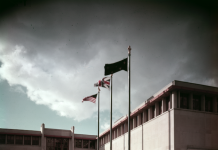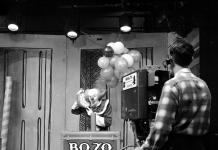1957 Looking south from the corner of Joseph Campau and Caniff, this photo shows Hamtramck’s main business artery, Joseph Campau, a busy hub of retail shops, theaters, bakeries, and auto dealerships.
OneĚýcan see (its green neon sign once a fixture in almost every metro Detroit neighborhood) on the left, as well as Fromm’s Hardware and, in the distance, Federal’s department store.
In the foregroundĚýat right is the , which opened in 1924. The 1957 romantic comedy Love in the Afternoon, starring Audrey Hepburn and Gary Cooper, tops the marquee, followed by the sci-fi flick Not of This Earth, a Saturday matinee. Horror and science-fiction pictures were theater mainstays on Saturday afternoons in the ’50s, a time when TV sets were not in every household and programming options were slimmer.
This writer has a distinct memory of the Martha Washington. Back in the late 1970s, a group of fellow opera lovers and I attended a film version of Borodin’s Russian opera Prince Igor at the theater one bone-chilling Sunday afternoon. Apparently the theater had been struggling, because the heat was scarcely on, and we watched the film in overcoats, scarves, and hats.
, a 2.1-square-mile town, is celebrating its 100th birthday as a city this year. It’s surrounded almost entirely by Detroit, save for a sliver of land that borders Highland Park. The city has an additional reason to be festive in 2022 with the renovation of Hamtramck Stadium, where, in the 1930s, Negro League teams such as the Detroit Stars and Detroit Wolves played.
Hamtramck (originally Hamtramck Township) was once populated mainly by German farmers, before Polish immigrants moved in, especially after the opening
of the Dodge Main plant in 1910. Today, the majority-Muslim town is occupied primarily by Bangladeshi and Yemeni residents.
“We have such an incredibly dynamic city in Hamtramck, and I’m proud of our history as a city of immigrants,” Greg Kowalski told the Detroit Free Press earlier this year.
Kowalski is the author of 11 books on his hometown and serves as the executive director of the Hamtramck Historical Museum. His feet — and heart — are planted firmly in Hamtown.
“I am a lifelong Hamtramck resident,” he tells me in a recent email. “I will never leave here.”
This story is from the NovemberĚý2022 issue of Â鶹·¬şĹ Detroit magazine. Read more in our digital edition. Check out even more historical photos of Detroit in The Way It Was archives at Â鶹·¬şĹDetroit.com.Ěý
|
| Ěý |
|








